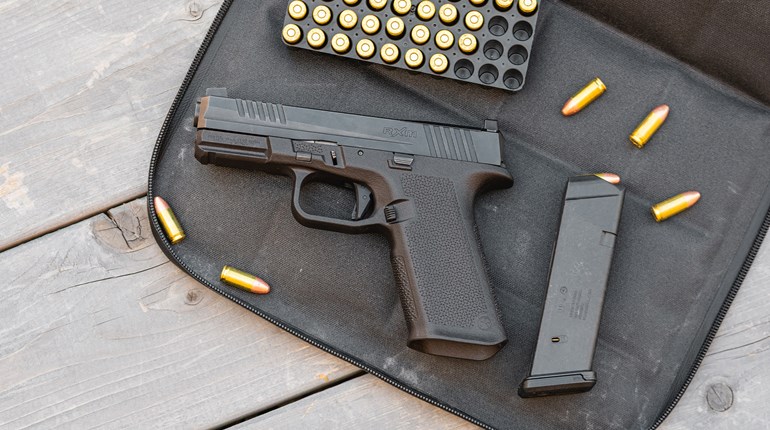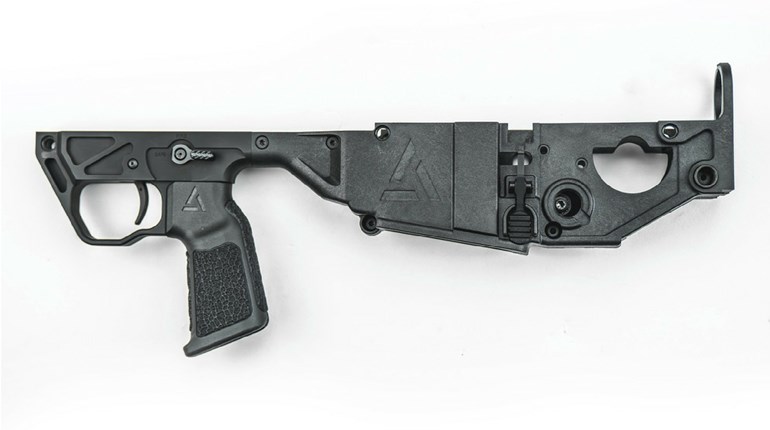
We’ve spent some time recently talking about optimizing your grip on a handgun. We broke our model into two parts—architecture and mechanics.
A reprise is simple. Architecture is where you want to be at the end of the draw and the start of the shot. Proper head, hand and arm position make controlling the shot itself much easier. Mechanics is what happens as you move from these “presentation” components to controlling and dispersing the energy of the shot itself. The goal of both is to limit misaligning movement as the shot is executed, and managing recoil thereafter. Doing so makes subsequent shots both faster and more accurate.
But thoughtful readers had questions about how the firearm itself fits into this equation. Ergonomics consist of more than the shape and angle of the grip and how it fits your particular hand. It’s certainly an important factor, but one where the various considerations spill over into tastes in a hurry. People are entitled to their preferences. (A classic example: the impassioned discussions of grip angle that have raged for 30-plus years between 1911 and Glock shooters.)
Where those preferences stack up most is grip texture. We routinely encounter folks who love their particular pistol, yet don’t realize they have serious grip problems with that handgun. The most obvious telltale sign is the notorious “flutter” of the weak hand fingers, sometimes seen between every single shot. To be direct, this reset of the grip is a massive barrier to improvement. A more critical eye might even judge it unsafe.
Never, though, has this been more fixable. If our grip suggestions still leave you feeling insecure on your handgun, check out these possible solutions.
“Make Stuff Feel Sticky” options — These are substances that you can apply either to your hands or to the surface of the pistol grip, and by design are not permanent. ProGrip (here at Brownells) is specifically for shooters and is excellent, but there are options from other sports like golf and tennis. These take various approaches to creating that tacky feel, and are strictly a matter of taste.
Downsides? They won’t help much for improving concealed-carry grip as they’ll interfere with lots of other daily activities. Despite promises to the contrary, most leave some slight residue—fine for training or competition, but a potential problem for carry.
“Make Stuff Feel Grippy” options
Here, think skateboard tape. While actual skateboard tape is too rough for most people, there are many versions for shooters that sport a finer grit/texture.
Many folks grab these the first time around and think, “Oh-oh, too much of a good thing.” In the long run, this is rarely true for a couple of reasons. First, it’s a big change, and the contrast is what is so apparent. The best way to solve this is to shoot a training pal’s firearm with the treatment you’re considering. The first session may be a little abrasive, but a second at least is needed to draw a sound conclusion.
Another factor to keep in mind is that these textures get “knocked down” in early use, and the stasis they reach is a lot more comfortable than you’d expect. These materials also remain effective with surprising amounts of contaminants—sunscreen, perspiration, gun lubricants/cleaners and the like.
They’re generally adhesive, and take a little caution and prep to apply. (A hint: Once they’re on, wrap your grip six ways from Sunday with rubber bands, though not over-tight so that things start skidding around. Leave it this way for a day or two, and your application will be much more secure.) A couple of favorites are here and here at Brownells. These have proven to be surprisingly resistant to cleaning solutions, though we’re careful in this regard. Don’t test our success by soaking them down.
Two variants of note: Rubber versions of these are available, too. We don’t like them because their effectiveness seems to alter with temperature, both high and low, and they seem to grab some garments unconstructively. This, however, works very well indeed, and particularly appeals to women: It actually makes the grip much, much softer. “Wet” performance is as promised—superb—but application is of necessity painstaking. (We cut through for the mag release, not cover it as the directions suggest; a personal preference.) It’s absolutely dynamite for a concealed-carry firearm for obvious reasons.
One final caveat regarding any variation on skateboard tape: They’re murder on garments. Seriously, you can wear right through the lining of a cover garment in a couple of hours if your luck is bad enough (though the Brooks Tactical noted above avoids this neatly), so they’re “out” for CCW use. If you’re up-gripping a competitive gun, make sure you understand where the grip enhancements can reside. Rule-wise, you can’t just slap tape on any old place. Many manufacturers provide die-cut tape pieces that can’t be legally added in some divisions—especially USPSA Production. (Yeah, there’s a story there …)
Note that all these treatments add girth to the pistol, though the tactile advantages they provide overshadow any dimensional issues.
“Fix The Gun” options
We have a key word for you here: stippling. This is a process by which you actually alter the surface of the gun. On metal guns (and rifle furniture), it is generally called “checkering,” but the result is the same: Some tool or process is used to create small-scale ridges and valleys on an otherwise flat surface. The result is much the same as skateboard tape, though you have a far greater range of granularity. Polymer, striker-fired pistols are where you see this most.
The advantages of stippling are manifold. For starters, it’s essentially permanent. Heat is the principal engine of the texture change, often simply a soldering iron. It can be applied to virtually any polymer surface, and there’s no requirement that it even be uniform. We’ve seen several patterns that were not only texture, but also “art”: A heated hex wrench, for instance, applied over and over again rendered one of the coolest patterns we’ve seen. As to effectiveness, we couldn’t say.
Lots of folks do this themselves, and while it’s certainly not a problem, a few cautions are advised. First, a little goes a long way. You can always add depth or “severity” to your stippling job, but removing it will be tricky, or even impossible. Overdone, stippling can seriously weaken your pistol, and most manufacturers would understandably consider this a warranty-buster.
Lastly, “cool” or “just right” is in the eye¬—or hand—of the beholder: Your stippling had better work well and solve a real problem, because the salability of that firearm may be compromised. (This is one of the reasons we like adhesive solutions—zip-zip, off it comes, back to “stock.”) We are not saying, “Don’t,” but we are saying think it through.
“Fix The Gun” options, Part II — Some pistols have changeable grip panels, and have had for decades. The most obvious are 1911s, but they aren’t the only ones by a looooooong chalk. Suffice it to say that this discussion could be several articles in and of itself. Hogue, for instance, has a dizzying variety of grip treatments and enhancements. (This is a really cool favorite of ours that is a Nationals-tested grip and magwell solution for 1911 fans.)
It’s worth observing that handgun manufacturers have paid a lot more attention to grip texture (and size/shape) over the last decade, and with good cause: The pros in military, law enforcement and the competitive world have barked a lot about the whole retention issue. The good news here is that manufacturers—both of firearms and add-on products—have listened and gotten to work. Big time.
If your handgun seems slick, even with our suggestions about grip architecture and mechanics, you’ve never had more ways to attack that barrier to better shooting.
Now Carry on.





































